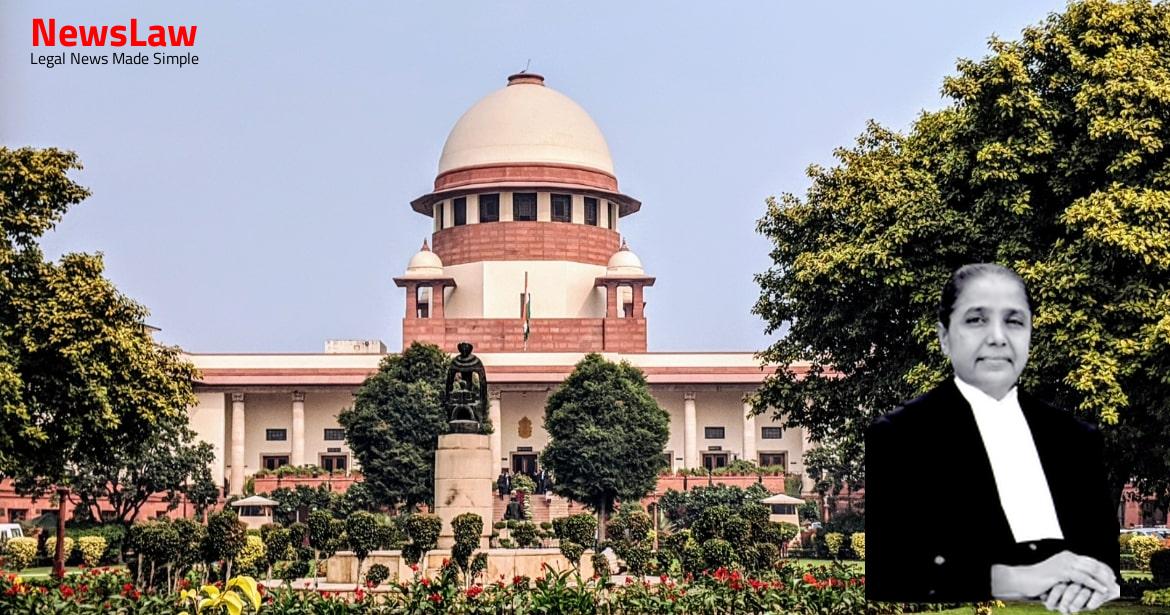Delve into a detailed examination of the court’s legal analysis in a recent conviction appeals case. This blog sheds light on the interpretation of crucial legal principles by the court, providing valuable insights into the complexities of the judicial process.
Facts
- Accused Ganesan and Shanmugam have filed separate Criminal Appeals against the High Court’s judgment confirming their conviction under Section 397 IPC.
- Accused Benny was acquitted in Sessions Case No. 12 of 2018 after being apprehended 15 years post the offence.
- The trial court convicted the accused in S.C. No. 363 of 2009 under Section 397 IPC and sentenced them to 7 years RI each.
- PW1 Duraisamy was attacked near Vallalar Street, Panruti by A3 Prabhakaran with an iron rod.
- A2 Benny assaulted witness Palanivel while trying to escape.
- Accused 2 to 5 plucked the bag containing Rs.60,000 and jewelry from Duraisamy’s bicycle.
- Charges were initially filed against 5 accused under section 395 read with section 397 IPC.
- A2 Benny and A5 Shajahan absconded, leading to trial separation.
- Ganesan, Prabhakaran, and Shanmugam proceeded to trial.
- Shajahan is still absconding.
- The prosecution examined 15 witnesses and presented documentary evidence.
- Witnesses included PW1 Duraisamy, PW2 Palanivel, PW5 Shanmugam, and PW10 Doctor Elangovan.
- A2 to A5 were alleged to have jointly committed robbery with weapons on the date in question.
Also Read: Legal Analysis on Conviction Based on Sole Testimony of Prosecutrix
Arguments
- Even the PWs could not identify and point out who beat PW1 and PW2.
- Some accused were identified in court, while others were arrested based on confession statements.
- Non-identification of all accused by witnesses does not vitiate the prosecution’s case in robbery and dacoity cases.
- Dacoity is an exaggerated version of robbery, requiring five or more accused.
- Discrepancies in PW1’s testimony after a 14-year lapse should not be used against him.
- Charge sheet filed against five accused, two absconded, trial proceeded against three.
- Delay in filing charge sheet and conducting trial noted.
- Conflicting statements by witnesses regarding identification and events.
- Questioning the admissibility of confession statements and lack of evidence for substantive charges.
- Concerns raised about the number of accused, reliance on confessions, and overall evidential consistency.
- Reliance placed on Rafiq Ahmad vs State of U.P., (2011) 8 SCC 300 and K. Prema S. Rao vs Yadla Srinivasa Rao, (2003) 1 SCC 217.
- Charge rightly framed for offences under Section 395 read with Section 397 IPC.
- Prosecution proved the ingredients for the offences beyond reasonable doubt.
- Alternatively, the conviction of the accused under Section 397 IPC can be sustained.
- Learned Counsels for both parties heard at length.
- Original Accused No.1 – Ganesan and Accused No.3 – Shanmugam @ Babu challenging their conviction for the offence under Section 397 IPC.
- Appeal prayed to be dismissed.
Also Read: Legal Analysis on Concurrent Sentences in Drug Trafficking Cases
Analysis
- The accused were present at the time of the offense and actively involved as established by witnesses.
- The involvement of five or more persons in a robbery is essential for Section 391 IPC punishable under Section 395 IPC.
- The prosecution must prove the presence and participation of the accused in the offense beyond reasonable doubt.
- The requirement for Section 397 IPC involves the use of a deadly weapon or causing grievous hurt.
- The offense of ‘dacoity’ is an exaggerated version of ‘robbery’ with a difference in the number of accused.
- Conviction can be adjusted based on the gravity and nature of the offense, ensuring justice is served.
- Contradictions in witness testimony are not deemed material if they do not affect the prosecution’s case as a whole.
- The crucial factor is the commission of the offense by five or more persons, not the number of persons tried.
- Interpreting the use of deadly weapons in the context of Section 397 IPC is crucial for establishing guilt.
- The basic principles of law remain consistent in determining the seriousness of an offense and appropriate punishment.
- Conviction for a minor offence can be sustained even if a charge for a major offence is not made out.
- PW1 and 15 other witnesses supported the prosecution’s case.
- Acquittal of one accused in a subsequent split trial does not automatically benefit other accused if the prosecution has successfully proven the case against them.
- Acquittal of some accused does not mean all accused should be acquitted if appropriate reasons for conviction have been given.
- Accused who did not use any deadly weapon during robbery cannot be convicted under Section 397 IPC for minimum punishment.
- The term ‘offender’ in Section 397 IPC is limited to those who use deadly weapons.
- Dacoity occurs when five or more persons jointly commit or attempt to commit robbery.
- Punishment for robbery under Section 392 IPC is rigorous imprisonment for up to ten years and a fine.
- Constructive liability can lead to conviction under Section 391 IPC for dacoity or dacoity with murder if five or more persons are involved in the robbery.
- If murder is committed during dacoity, each participating individual can be punished with death, life imprisonment, or rigorous imprisonment up to ten years, along with a fine.
- Section 397 IPC pertains to robbery or dacoity with an attempt to cause death or grievous hurt, imposing a minimum of seven years imprisonment if a deadly weapon is used.
- The offender, as per Section 397 IPC, refers to the one who actually uses a deadly weapon during the crime.
- There is a distinction between ‘uses’ in Section 397 and ‘armed with’ in Section 398 IPC.
- Use of a deadly weapon by one offender during robbery does not warrant minimum punishment under Section 397 IPC for co-offenders who did not use such a weapon.
- Presence of the offender near the victim to induce fear is sufficient, and the weapon does not necessarily need to be physically used.
- Committing robbery with a deadly weapon can result in a minimum of seven years imprisonment under Section 397 IPC.
- The terms ‘robbery’ and ‘dacoity’ differ in the number of individuals involved in the crime.
- Punishment for dacoity can include imprisonment for life, while robbery entails rigorous imprisonment for up to ten years.
- Jointly committing robbery or attempting to commit it falls under the definition of dacoity.
- Section 398 IPC addresses attempting robbery or dacoity while being armed with a deadly weapon, requiring a minimum of seven years in imprisonment.
- The view expressed in the cases of Raja and Gangadhar is similar.
- The acquittal in Benny’s case was due to specific facts and evidence.
- The present accused have been proven guilty by the prosecution’s evidence.
- The appellants-accused should not be acquitted based on the above reasons.
Also Read: Legal Jurisdiction and Award Finality in Arbitration Dispute
Decision
- The appeals are partly allowed
- Conviction for the offence under Section 397 IPC is set aside
- Accused are convicted for offences under Section 391 IPC punishable under Section 395 IPC
- Sentenced to undergo seven years RI and pay a fine of Rs.2,000/-
- In default of fine payment, to undergo further six months RI
Case Title: GANESAN Vs. STATE REP. BY STATION HOUSE OFFICER (2021 INSC 698)
Case Number: Crl.A. No.-000903-000903 / 2021



